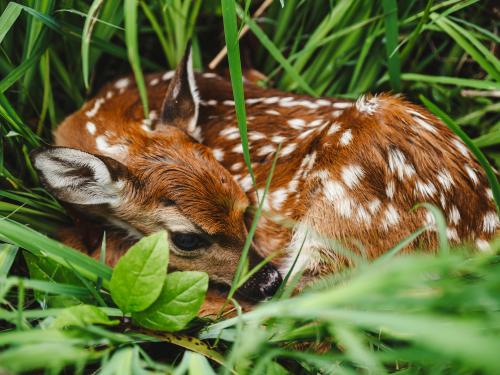
In the forests of my childhood, invasive honeysuckle makes for a dense woody undergrowth that crowds out other plants of the forest floor. That is one way to explain the loss of chokecherry, serviceberry, inkberry, spicebush, and viburnum. Though another way to understand what is happening is that Missouri was logged three times over, then parceled out for monocropping by corporate agriculture, and honeysuckle is the kind of plant that is drawn to disturbed soil. It holds the banks and ravines and nitrogen and whatever is left of that whole nutrient-rich layer of loam until the soil is not disturbed anymore.
A friend who does conservation work on Iowa prairies a few hours north told me about a huge fight she had with one of her neighbors out in the middle of the town’s tiny piece of remnant prairie because of how he was spraying herbicides on invasive species. She was exasperated, enraged really, by the idea you’d pour poison in the ground to save anything.
She pointed to a grove of young black walnuts bushing up in the center of the field. That used to be one ancient walnut tree, but this neighbor got the Parks Department to cut it down because it is an invasive. With all of the extra sun, walnut seeds, which had lain dormant in its shade for generations, sprang up, even as the roots did what they do when the earth above them is laid bare, which is sucker forth new saplings everywhere the old tree had cast its shadow. My friend was dismayed at how much more prairie would be lost this way.
She cares so much, her neighbor cares so much, nobody knows what to do. They just want to see the grasses grow. So they bickered and accused each other all the way back to the parking lot.
When we lived on a scrap of prairie in rural Missouri, I thought first occasionally and then often about leaving my husband. Though I grew up in the city, I’d never lived as far outside of nature as I did when we were homesteading. Our eight acres were an island in a sea of corn and soybeans.
Every weekend, it seemed, Brian was lost in the woody strips edging our small field. First he went in with a hand axe, determined to remove every bough of honeysuckle. The next year he tried again, this time with a small blowtorch to burn the stumps and prevent them from suckering back to life.
Out among the black-eyed-Susans and Queen Anne’s lace, I buried myself in the other side of the yellow honeysuckle blossoms he was hacking at. Basket in hand, I pushed deep into the brush, head covered in pollen, bees buzzing my knotted hair, to gather flowers I distilled to a syrup that was delicious to drizzle over biscuits. He could have spent his whole life chopping and never kept back more than a single glade the circumference of the body of a deer with her fawns. He was just a man and the honeysuckle was an ocean.
It is not the nature of a prairie to stay in one place. They are slower than water but have their own ebb and flow, following after the tides of grass fires and grazing buffalo. The forests follow them, more fires follow the forest; these succession cycles are as much what a prairie is as the grasses. All we have now are the last islands of an oceanic being.
After a few years, we gave up and moved back to the city, where we became better at loving each other and also our neighbors, which made us able to miss the land we’d left behind. One drought summer when the haze from huge wildfires to the north made it as clear as it had ever been that we were already at the end of the world, I became convinced fireflies had gone extinct. I drove Brian out to the country and refused to go home until I had seen one at least. Finally, where thickets of honeysuckle reached the water’s edge, I saw a light and then three. Hardly more than that.
Though honeysuckle is not good for birds, there are more birds in woods with honeysuckle than where the honeysuckle has been removed, as their choices have been reduced to some kind of berry, or none.
The last day we lived on that farm I’d grown to hate for how small my life felt then, we took one last walk around the acreage. The path was lined with his blackened stumps. From the center of each a sprig of green wood sprang forth, bolting after the sun. He sighed at the futility of his work and I did too.
When I think of all the mistakes I’ve made in this life, though, I remember how we finally reached the glade he had carved with the blistered hands of what I thought was a futile obsession, a perfectionist’s need to control. The ground in that spot was covered now in mayapple, a native species that grows across old forest floors. I hadn’t come across one in several years. I reached beneath the broad leaf to see if there might be a green and tangy fruit for us to suck on as we walked. They were all gone—deer love a mayapple. They lower their heads down to the leaves and then reach out those muscular and agile tongues, long enough to curl around a single berry and pluck it from the branch, barely even rustling the tender leaf above.
